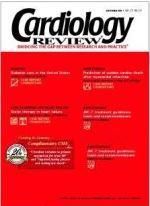Publication
Article
Uric acid as a prognostic marker in chronic heart failure
Despite advances in the understanding of its pathophysiology and pharmacotherapy, the diagnosis of chronic heart failure remains profoundly morbid. Numerous prognostic markers that allow the prospective identification of clinical risk strata have been identified. Many of these, however, such as serum catecholamine levels, tumor necrosis factor-alpha, and formal metabolic testing, are not widely available.
Only one prognostic stratification system has been prospectively validated, the seven-parameter heart failure survival score (HFSS); however, this multifactorial model is probably too complex for routine application. A simple parameter that predicts prognosis in chronic heart failure patients and is easily assessed would be valuable.
Hyperuricemia is a common finding in patients with chronic heart failure and is independent of diuretic use and renal impairment.1 Uric acid (UA) levels rise in parallel with New York Heart Association (NYHA) functional class.2 They are independently associated with cardiovascular mortality both in the general population3 and in high-risk groups, including patients with hypertension, diabetes mellitus, and chronic heart failure.4 The relationship between serum UA levels and survival and its ease of measurement makes UA a potentially ideal prognostic variable.
The study by Doehner and Anker (page 25) investigated the hypothesis that UA levels can be used as a prognostic marker in patients with chronic heart failure. They also hypothesized that UA levels provide a staging system for assessing prognosis in chronic heart failure when combined with measures of cardiac function (left ventricular ejection fraction) and patient functional status (maximal oxygen consumption [VO2] with exercise). To explore this, the authors assessed the relationship between survival and UA level in a derivation sample and a validation sample of patients with chronic heart failure. A post hoc calculation of the seven-parameter HFSS was performed in 194 patients, and its prognostic value was compared with that of UA level. Finally, the authors documented the survival of patients with chronic heart failure in relation to a three-risk-factor model that included a high UA level above 565 µmol/L
(> 9.5 mg/dL) as a marker of metabolic status, a low peak VO2 (≤ 14 mL/kg per minute) as a marker of low functional capacity, and a low ejection fraction (≤ 25%) as a marker of poor cardiac function.
Results from the derivation study showed that an elevated UA level predicted mortality. Receiver-operator curve analysis showed the best UA level for predicting survival status at 12 and 18 months was 565 µmol/L (9.5 mg/dL). This was confirmed in the validation study, and for every additional 1-mg/dL increase in UA level there was an increase in risk of approximately 30% during the 2 years of follow-
up. In patients with UA levels of
565 µmol/L or higher, survival was 52% at 12 months and 36% at 24 months. In those with UA levels below 565 µmol/L, survival was 92% and 86% at 12 and 24 months, respectively. When considering all patients from both cohorts, a highly significant graded relationship was found between serum UA level
and chronic heart failure mortality (chi-square test, 76.2; P < .001). In
a multivariate Cox regression model with seven variables, only UA
level (P < .001), left ventricular ejection fraction (P < .04), and peak VO2 (P < .005) predicted survival.
The authors also showed that HFSS and UA level predicted prognosis independently of each other. Applying the best UA level cutoff
(≥ 565 µmol/L) to the HFSS subgrouping improved the positive and negative discriminatory power for predicting survival in all HFSS
strata. The cumulative metabolic, functional, and hemodynamic score (the triad of factors including high UA level, low VO2, and low left ventricular ejection fraction) was highly predictive of death or heart transplantation. Of 120 chronic heart failure patients with a score of 3, 81% were subsequently listed for transplantation. None of those with a score of 0 to 1 were listed.
Thus, the data support the hy-
pothesis that UA level provides a strong, independent marker of impaired prognosis in patients with moderate to severe chronic heart failure, and that this relationship is graded. The study also showed that UA level predicts prognosis independently of the HFSS, and when added to this score, improves its prognostic power. For these reasons, and because of the ease with which UA levels can be determined in routine clinical practice, the study is important and timely and provides the astute clinician with a valuable disease marker.
As in all studies of chronic heart failure patient cohorts, this study is limited by the clinical characteristics of the populations studied. Patients were mostly men and mostly ischemic, and only a minority (6%) were treated with beta blocking agents. Moreover, the patients tended to have a poor NYHA functional class (mean, 2.7) to begin with, and no information was provided about serial UA testing as a measure of treatment efficacy.
Acknowledging these limitations, the study does raise some intriguing biological questions: Why is UA elevated in this context? Is it epiphenomenal or does the UA itself contribute to the progression of disease? Finally, does treatment targeted at UA or the pathways that lead to its production alter the natural progression of chronic heart failure? The answers to these questions are unclear, but there are interesting suggestions in the literature. UA is a byproduct of purine metabolism, and elevated serum levels reflect either increased generation, such as from tissue destruction, increased xanthine oxidase activity, or both, or decreased renal excretion. Because xanthine oxidase activity is up-regulated in the heart in both human and animal models of chronic heart failure, increased UA generation via xanthine oxidase is likely significant.5,6 Xanthine oxidase itself has potentially deleterious effects in chronic heart failure, both by mechanoenergetic uncoupling and via altered myofilament calcium sensitivity.5,7 Moreover, xanthine oxidase is a major contributor to the production of superoxide anions and thus oxidative stress, which has been linked to processes associated with endothelial dysfunction, the local release of inflammatory cytokines, and the activation of ectoproteases that might contribute to cardiac dilation and cell loss.8-11
Conclusion
It is reasonable to postulate that the metabolic pathways leading
to UA elevation in chronic heart failure are not epiphenomenal but
may contribute to disease progression. The availability of pharmacologic agents that specifically target xanthine oxidase activity, such as allopurinol, raises the question of whether this potentially deleterious sequence of events could be targeted and interrupted. Several animal studies and a few clinical observations have suggested that allopurinol has beneficial structural and functional effects in heart failure patients.5,6,12,13 The present observational study would certainly encourage this line of investigation.





